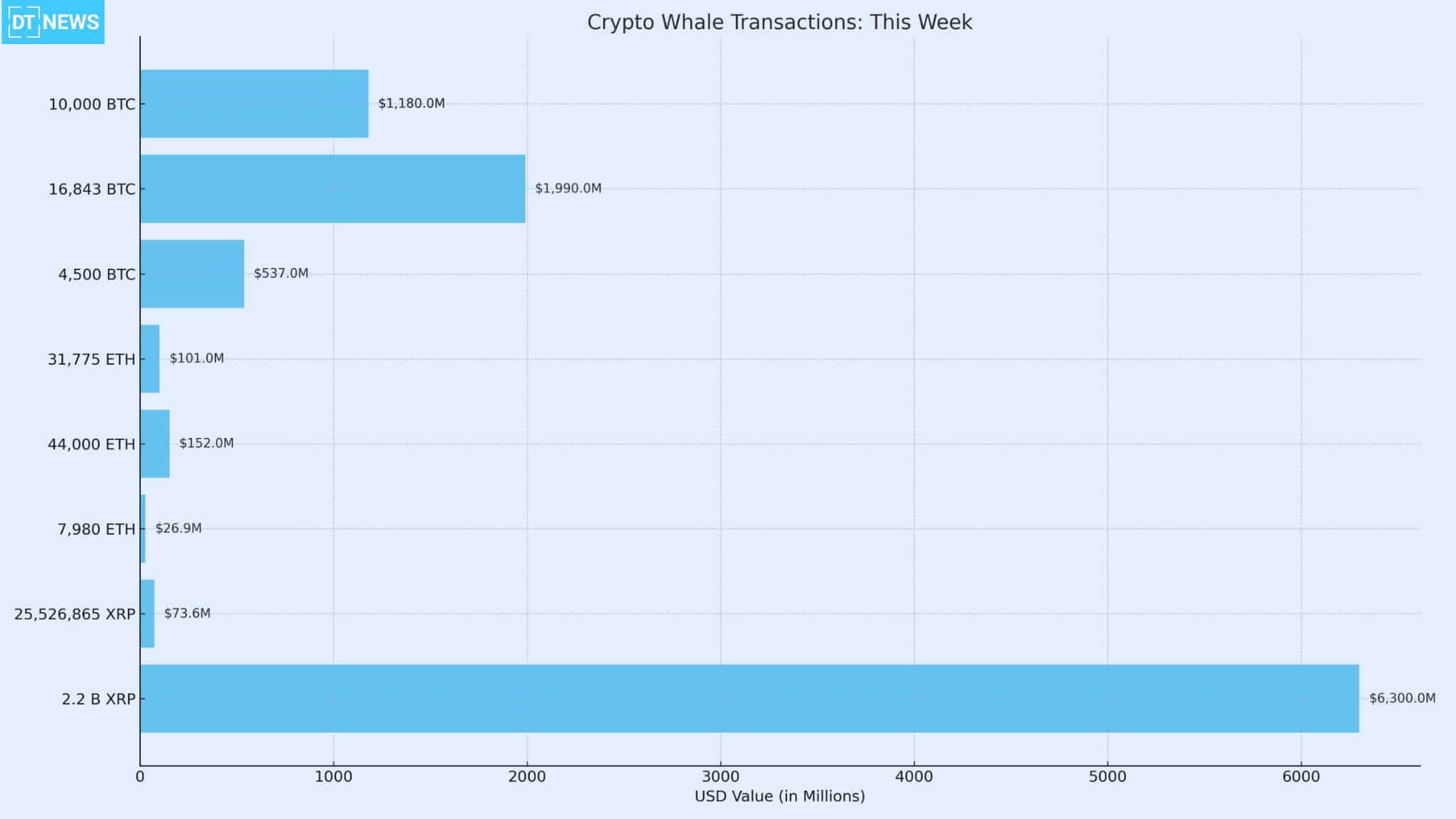This week, crypto whales made a bunch of big transactions that got everyone’s attention. Citing a notable one, a long-dormant Satoshi-era Bitcoin whale moved 16,843 BTC ($1.99 billion) to Galaxy Digital just recently. Analysts say these kinds of moves can be profit-taking or re-allocating. Shortly after these moves, Bitcoin’s price dropped more than 5%.
Meanwhile, crypto whales were also accumulating, as on-chain data shows Ethereum whales’ net inflows spiked 95% over the past week, signifying heavy buying pressure.
Big Bitcoin Whale Transfers
Bitcoin had some of the biggest whale activity of the week. Whale Alert reported a 442.91 BTC transfer ($52.8 million) from an unknown wallet to Coinbase’s institutional account. Then an ancient whale holding 80,000 BTC for 14 years moved 10,000 BTC ($1.18 billion).
Over the following days, about 20,000 BTC ($2.42 billion) accumulated at that same address. These big on-chain transfers, often splitting coins into new addresses, mean the whale is reorganizing their holdings rather than selling.

Sources reported that this Satoshi era whale made two big transactions of 9,000 BTC ($1.06 B) and 7,843 BTC ($0.93 B) to Galaxy Digital. Galaxy then sent some of the coins to exchanges which coincided with a $6,000 drop in BTC’s price.
The whale’s move caused Bitcoin’s “Coin Days Destroyed” metric to spike, a historical signal of market corrections after big holders move old coins.
Other big Bitcoin whale moves were to exchanges. An unknown investor sent 4,500 BTC ($537 M) to Galaxy Digital. Another old wallet just moved 10,000 BTC ($1.18 B) between unknown addresses, a probable consolidation or internal re-allocating. These transfers to exchanges or between cold wallets means big whale activity in Bitcoin.
Ethereum Whales
Ethereum also saw large crypto whale activity. Cumberland sent 31,775 ETH ($101 million) to Coinbase, it also sent another 44,000 ETH ($152 million). That is over 75,000 ETH in two days. Unlike deposits to exchanges which can be a sign of selling, Cumberland often acts as a liquidity provider and its moves can be hedging or client withdrawals rather than liquidation.
Interestingly, on-chain analytics show Ethereum large holders were net buyers. IntoTheBlock data shows ETH “large holders” saw net inflows of 95% week-over-week, which means whales bought more ETH than they sold, signaling a bullish trend.
Crypto Whales were also buying on exchanges. Sources reported that addresses like 0x9684, 0x35fb, and 0x3c9E were buying huge amounts of ETH. 0x35fb alone bought 80,312 ETH ($252 M) in 6 days. It was noted that 0x35fb withdrew 7,980 ETH ($26.9 M), part of 88,292 ETH ($298 M) outflow from Kraken in a week.
Large withdrawals from exchanges are bullish as it reduces sell-side pressure. Basically, Ethereum whales were repositioning this week
Altcoin Whales: XRP, Chainlink, ONDO and Others
Crypto whales weren’t just limited to the two biggest coins. A whale moved 25,526,865 XRP ($73.6 million) from an unknown wallet to Coinbase. This was during the broader XRP rally. Sources reported that whales had accumulated about 2.2 billion XRP in the past two weeks by mid-July. These big XRP purchases and transfers coincided with renewed confidence in Ripple as legal clarity approaches.
Other altcoins saw whale activity too. Santiment data showed a mid-tier whale group bought 3 million ONDO tokens in early July. ONDO (a RWA token) was rising as whales thought it could break key resistance. Chainlink (LINK) also saw whale momentum: high-value LINK transactions were surging recently, some analysts are eyeing $15+ targets for LINK.
Overall, crypto whales are diversifying. Institutional investors and large holders are repositioning, not just in Bitcoin and Ethereum but in altcoins too.
| Asset | Amount | USD Value | From | To | Notes |
| BTC | 442.91 BTC | $52.8 M | Unknown wallet | Coinbase Institutional | First BTC whale move of the week |
| 10,000 BTC | $1.18 B | Ancient wallet | New address | Wallet total reached 20,000 BTC | |
| 9,000 BTC + 7,843 BTC | $1.06 B + $0.93 B | Satoshi-era whale | Galaxy Digital | Caused price dip and Coin Days Destroyed spike | |
| 4,500 BTC | $537 M | Unknown wallet | Galaxy Digital | Possibly institutional sale | |
| 10,000 BTC | $1.18 B | Unknown wallet | Unknown wallet | Internal reshuffling | |
| ETH | 31,775 ETH | $101 M | Cumberland | Coinbase Institutional | Liquidity provision or client trade |
| 44,000 ETH | $152 M | Cumberland | Coinbase Institutional | Brought total ETH sent to 75,775 in two days | |
| 7,980 ETH (of 88,292 W) | $26.9 M | Kraken | Wallet 0x35fb | Part of 88K+ ETH withdrawn (bullish signal) | |
| XRP | 25,526,865 XRP | $73.6 M | Unknown wallet | Coinbase | Significant move amid XRP rally |
| 2.2 B XRP (cumulative) | $6.3 B+ | Multiple sources | Whales accumulation | Driving XRP price above $3 | |
| ONDO | 3 M ONDO | N/A | Mid-tier whales | Unknown | Anticipating bullish breakout |

Crypto Market Impact
These big crypto whale transactions have caused market volatility this week. When whales move assets to exchanges it can add sell pressure. For example, after the Satoshi era whale sold 16,843 BTC via Galaxy Digital, Bitcoin’s price dropped by 5% and everyone feared a big sell off.
Similarly, Cumberland’s ETH move into Coinbase might increase near term supply but they could also be providing deep liquidity to the market.
Whale buying and withdrawals can boost prices. Ethereum’s big inflows and Kraken withdrawals by whales (0x35fb) are bullish. XRP whales scooping up tokens (the 25.5M XRP deposit and the 2.2B accumulation) helped XRP go above $3. Technical analysts note that whales’ moves often precede price rallies.
Conclusion
Based on latest research, crypto whales were busy over the course of the week. Big transfers in Bitcoin and Ethereum, and notable moves in altcoins. Satoshi-era and institutional whales moved thousands of BTC to exchanges and new addresses. Ethereum saw over 75,000 ETH flow to Coinbase via Cumberland, even as whales’ net inflows hit all time high.
In altcoins, whales accumulated XRP (2.2 billion tokens) and other assets, as those coins rallied. These whale moves caused short term volatility (BTC deposits to exchanges pressured prices); but overall, they show strong demand from big holders.
If whales keep accumulating big assets while keeping supplies tight, it could sustain the crypto bull market.
Stay up to date with expert analysis and price predictions by visiting our crypto news platform.
Summary
This week’s biggest crypto whale transactions were a $1.99 B transfer of 16,843 BTC from a long dormant Satoshi-era wallet, multi-billion dollar moves of 10,000+ BTC between cold addresses, and huge Ethereum moves of 31,775 ETH and 44,000 ETH, from Cumberland to Coinbase. On-chain analytics show Ethereum whales’ netflow spiked 95% signaling heavy buying. XRP whales bought over 2.2 B tokens. In each case, whale activity is driving the market
FAQ
What is a crypto whale?
A crypto whale is an individual or organization that holds a very large amount of cryptocurrency (often greater than 0.1% of total supply). Whales can move the market when they buy or sell big volumes and cause big price swings.
Why do whales transfer coins to exchanges?
Moving crypto to an exchange often means the whale is going to sell or swap it; causing price drops. Withdrawals mean they are holding long term; often bullish. The recent whale deposits to Coinbase (BTC and ETH) added short-term supply, while big withdrawals like 0x35fb pulling ETH off Kraken were accumulation.
Can whale moves predict the market?
Sometimes. Unusual whale activity like moving Satoshi era coins after years can be a correction signal. But if whales are accumulating; it’s often a bullish sign.
Glossary
Crypto Whale: An individual/entity holding a large amount of a cryptocurrency.
Netflow (on-chain): The difference between the amount of a cryptocurrency whales buy vs. sell over a period.
Coinbase Institutional: A custodian platform for large investors run by Coinbase.
Cold Storage: Offline storage (like hardware wallets) where investors hold crypto long term.
Coin Days Destroyed (CDD): An on-chain metric that multiplies the amount of coins by the days since they last moved.



















































































































